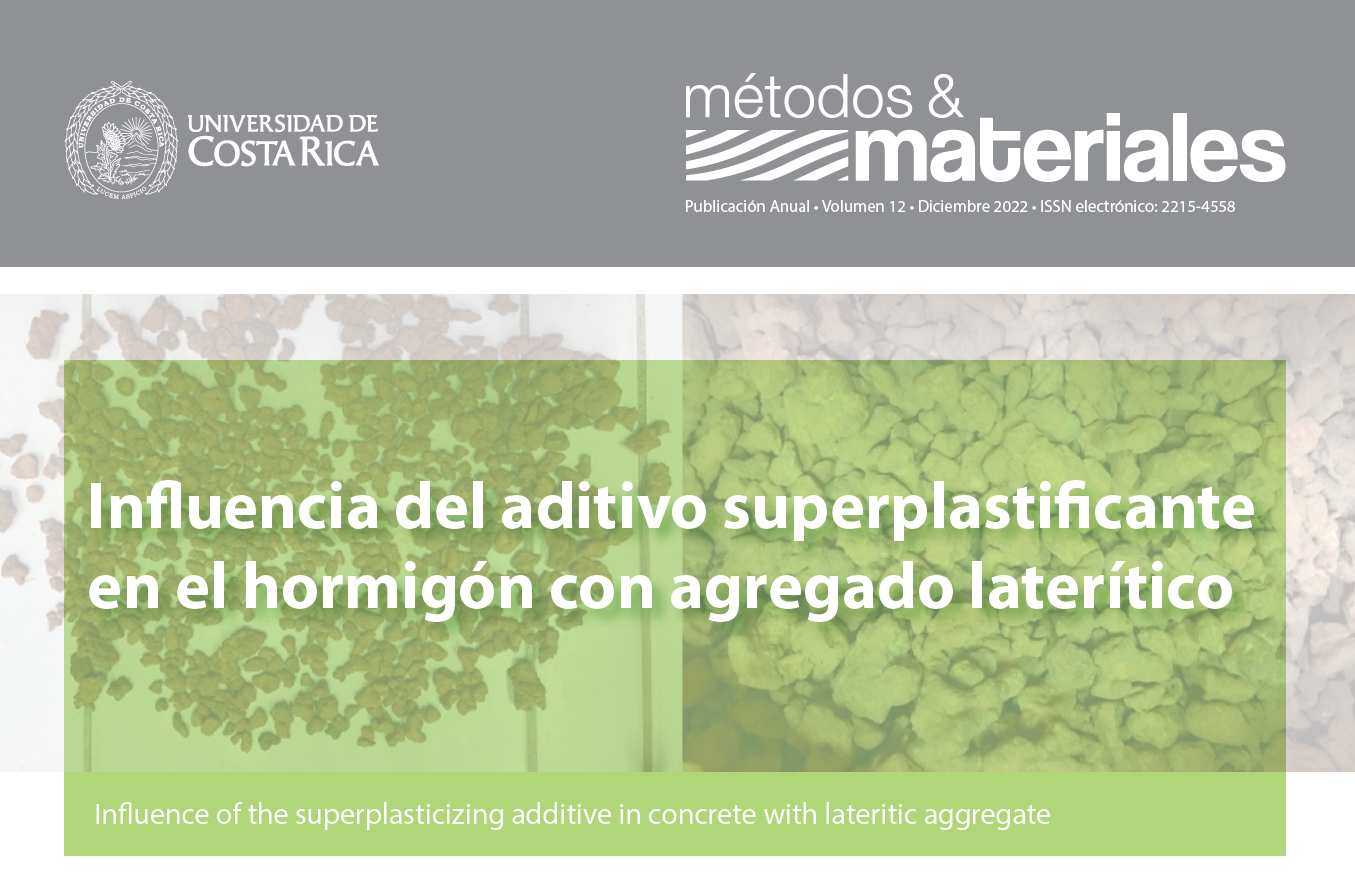Abstract
Due to the scarcity and high transportation costs of stone aggregates in the east and northeast of Bolivia, different alternatives have been sought for their partial or complete replacement in the construction industry and, specifically, to produce concrete. The objective of this research is to evaluate the workability, compressive strength, and ultrasonic pulse velocity (UPV) of concrete produced entirely with coarse lateritic aggregates and a commercial superplasticizer additive. Using the IPT/EPUSP method, concrete with coarse lateritic aggregate was dosed for 30 MPa (design compressive strength). Five different percentages of additive (by weight of cement) were considered: 0% (reference), 0.6, 0.8, 1 and 1.2%. Although the superplasticizer additive improves workability at higher percentages, the mixtures with 0.6, 0.8 and 1% presented higher compressive strength and VPU, when compared to the reference (0%). 1.2% of additive presented the lowest values of compressive strength and VPU. The use of additives, in this case superplasticizer, is beneficial for the workability and compressive strength of lateritic concrete, but the most appropriate content for its use must be defined.
References
Asiedu, R. O. (2017). Using lateritic gravel as all-in aggregate for concrete production. Journal of Engineering, Design and Technology. https://doi.org/10.1108/JEDT-01-2016-0001
Atoyebi, O. D., Modupe, A. E., Aladegboye, O. J., & Odeyemi, S. V. (2018). Dataset of the density, water absorption and compressive strength of lateritic earth moist concrete. Data in brief, 19, 2340-2343. https://doi.org/10.1016/j.dib.2018.07.032
Awoyera, P. O., Akinmusuru, J. O., & Ndambuki, J. M. (2016). Green concrete production with ceramic wastes and laterite. Construction and Building Materials, 117, 29-36. https://doi.org/10.1016/j.conbuildmat.2016.04.108
Awoyera, P. O., Dawson, A. R., Thom, N. H., & Akinmusuru, J. O. (2017). Suitability of mortars produced using laterite and ceramic wastes: Mechanical and microscale analysis. Construction and Building Materials, 148, 195-203. https://doi.org/10.1016/j.conbuildmat.2017.05.031
ASTM. (2012). Standard Test Method for Slump of Hydraulic-Cement Concrete. ASTM C143 / C143M – 12. West Conshohocken, PA: ASTM. https://doi.org/101520/C0143_C0143M-12
ASTM. (2014). Standard Test Method for Compressive Strength of Cylindrical Concrete Specimens. ASTM C39 / C39M – 14. West Conshohocken, PA: ASTM. https://doi.org/10.1520/C0039_C0039M-14
ASTM. (2015). Standard Test Method for Density, Relative Density (Specific Gravity), and Absorption of Coarse Aggregate. ASTM C127-15. West Conshohocken, PA: ASTM. https://doi.org/10.1520/C0127-15
ASTM. (2016). Standard Test Method for Pulse Velocity Through Concrete. ASTM C597 – 16. West Conshohocken, PA: ASTM. https://doi.org/10.1520/C0597-16
ASTM. (2019). Standard Specification for Chemical Admixtures for Concrete. ASTM C494/ C494 M -19. West Conshohocken, PA: ASTM. https://doi.org/10.1520/C0494_C0494M-17
ASTM. (2019). Standard Test Method for Sieve Analysis of Fine and Coarse Aggregates. ASTM C136-19. West Conshohocken, PA: ASTM. https://doi.org/10.1520/C0136-06
ASTM. (2021). Standard Specification for Blended Hydraulic Cements. ASTM C595 / C595M-21. West Conshohocken, PA: ASTM. https://doi.org/10.1520/C0595_C0595M-21
CEN. (2021). Testing concrete in structures - Part 4: Determination of ultrasonic pulse velocity. EN 12504-4:2021.
Celestino, M. A. D. S. (2018). Análise da curva tensão versus deformação do concreto laterítico. Tesis de licenciatura. Universidade Federal de Campina Grande.
Chagas, R. M. P. (2011). Estudo do concreto laterítico dosado com aditivo plastificante à base de lignosulfonato. Tesis de maestría. Universidade Federal de Campina Grande.
Fanijo, E., Babafemi, A. J., & Arowojolu, O. (2020). Performance of laterized concrete made with palm kernel shell as replacement for coarse aggregate. Construction and Building Materials, 250, 118829. https://doi.org/10.1016/j.conbuildmat.2020.118829
Fernández, J. M., Duran, A., Navarro-Blasco, I., Lanas, J., Sirera, R., & Alvarez, J. I. (2013). Influence of nanosilica and a polycarboxylate ether superplasticizer on the performance of lime mortars. Cement and Concrete Research, 43, 12-24. https://doi.org/10.1016/j.cemconres.2012.10.007
IBNORCA. (2015). Aditivos para la construcción - Definiciones y clasificación. NB 1000:2015. Bolivia.
IBNORCA. (2015). Aditivos para la construcción - Requisitos. NB 1001:2015. Bolivia.
IBNORCA. (2012). Cemento - Definiciones, clasificación y especificaciones (Tercera revisión). NB 011:2012. Bolivia.
IBNORCA. (2017). Hormigón estructural – Parte 1: Especificaciones. NB 1225001-1:2017. Bolivia.
Kaze, R. C., Naghizadeh, A., Tchadjie, L., Adesina, A., Djobo, J. N. Y., Nemaleu, J. G. D., ... & Tayeh, B. A. (2022). Lateritic soils based geopolymer materials: A review. Construction and Building Materials, 344, 128157. https://doi.org/10.1016/j.conbuildmat.2022.128157
Keulen, A., Yu, Q. L., Zhang, S., & Grünewald, S. (2018). Effect of admixture on the pore structure refinement and enhanced performance of alkali-activated fly ash-slag concrete. Construction and Building Materials, 162, 27-36. https://doi.org/10.1016/j.conbuildmat.2017.11.136
Madu, R. M. (1980). The performance of lateritic stones as concrete aggregates and road chippings. Matériaux et Construction, 13(6), 403-411. https://doi.org/10.1007/BF02473899
Muthusamy, K., & Kamaruzaman, N. W. (2012). Assessment of Malaysian laterite aggregate in concrete. International journal of civil and environmental engineering, 12(4), 83-86.
Nino, H. I. G., & Caldas, H. S. (2020) Propiedades geotécnicas de laterita y su comportamiento como sustituto del agregado grueso en mezclas de concreto.
Párraga, D. (2013). Implementación de la metodología MCT, aplicada al estudio geotécnico de suelos tropicales para su uso en pavimentos. Cochabamba - Bolivia: Universidad Mayor de San Simón.
Raja, R., & Vijayan, P. (2021). Investigations on mechanical characteristics and microstructural behavior of laterized high strength concrete mix. Arabian Journal for Science and Engineering, 46(11), 10901-10916. https://doi.org/10.1007/s13369-021-05606-7
Silva, G. C., Christ, R., Pacheco, F., de Souza, C. F., Gil, A. M., & Tutikian, B. F. (2020). Evaluating steel fiber‐reinforced self‐consolidating concrete performance. Structural Concrete, 21(1), 448-457. https://doi.org/10.1002/suco.201900141

This work is licensed under a Creative Commons Attribution-NonCommercial-NoDerivatives 4.0 International License.
Copyright (c) 2022 Métodos y Materiales


